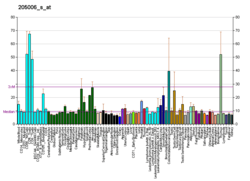NMT2
| Human N-myristoyltransferase 2 | |||||||||
|---|---|---|---|---|---|---|---|---|---|
|
Human N-myristoyltransferase isoform 2 (NMT2) (based on PDB: 4c2x) | |||||||||
| Identifiers | |||||||||
| Symbol | NMT2 | ||||||||
| Pfam | PF01233.14 | ||||||||
| InterPro | IPR022676 | ||||||||
| |||||||||
Glycylpeptide N-tetradecanoyltransferase 2 known also as N-myristoyltransferase, is an enzyme (EC: 2.3.1.97) that in humans is encoded by the NMT2 gene.[5]
Function
N-myristoyltransferase (NMT) catalyzes the reaction of N-terminal myristoylation of many signaling proteins. It transfers myristic acid from myristoyl coenzyme A to the amino group of a protein's N-terminal glycine residue. Biochemical evidence indicates the presence of several distinct NMTs, varying in apparent molecular weight and /or subcellular distribution. The 496-amino acid of human NMT2 protein shares 77% and 96% sequence identity with human NMT1 and mouse Nmt2 comprise two distinct families of N-myristoyltransferases.[6]
Interactions
NMT2 has been shown to interact with:
See also
References
- 1 2 3 GRCh38: Ensembl release 89: ENSG00000152465 - Ensembl, May 2017
- 1 2 3 GRCm38: Ensembl release 89: ENSMUSG00000026643 - Ensembl, May 2017
- ↑ "Human PubMed Reference:".
- ↑ "Mouse PubMed Reference:".
- ↑ Giang DK, Cravatt BF (Apr 1998). "A second mammalian N-myristoyltransferase". J Biol Chem. 273 (12): 6595–8. PMID 9506952. doi:10.1074/jbc.273.12.6595.
- ↑ Thinon E, Serwa RA, Broncel M, Brannigan JA, Brassat U, Wright MH, Heal WP, Wilkinson AJ, Mann DJ, Tate EW (2014). "Global profiling of co- and post-translationally N-myristoylated proteomes in human cells.". Nat Commun. 5: 4919. PMC 4200515
 . PMID 25255805. doi:10.1038/ncomms5919.
. PMID 25255805. doi:10.1038/ncomms5919. - ↑ Selvakumar P, Sharma RK (2007). "Role of calpain and caspase system in the regulation of N-myristoyltransferase in human colon cancer (Review).". Int J Mol Med. 19 (5): 823–7. PMID 17390089. doi:10.3892/ijmm.19.5.823.
- ↑ Selvakumar P, Lakshmikuttyamma A, Sharma RK (2009). "Biochemical characterization of bovine brain myristoyl-CoA:protein N-myristoyltransferase type 2.". J Biomed Biotechnol. 2009: 907614. PMC 2737134
 . PMID 19746168. doi:10.1155/2009/907614.
. PMID 19746168. doi:10.1155/2009/907614.
Further reading
- Kolluri SK, Balduf C, Hofmann M, Göttlicher M (2002). "Novel target genes of the Ah (dioxin) receptor: transcriptional induction of N-myristoyltransferase 2". Cancer Res. 61 (23): 8534–9. PMID 11731439.
- Wright MH, Clough B, Rackham MD, Rangachari K, Brannigan JA, Grainger M, Moss DK, Bottrill AR, Heal WP, Broncel M, Serwa RA, Brady D, Mann DJ, Leatherbarrow RJ, Tewari R, Wilkinson AJ, Holder AA, Tate EW (2014). "Validation of N-myristoyltransferase as an antimalarial drug target using an integrated chemical biology approach.". Nat Chem. 6 (2): 112–21. PMC 4739506
 . PMID 24451586. doi:10.1038/nchem.1830.
. PMID 24451586. doi:10.1038/nchem.1830.
This article is issued from
Wikipedia.
The text is licensed under Creative Commons - Attribution - Sharealike.
Additional terms may apply for the media files.






